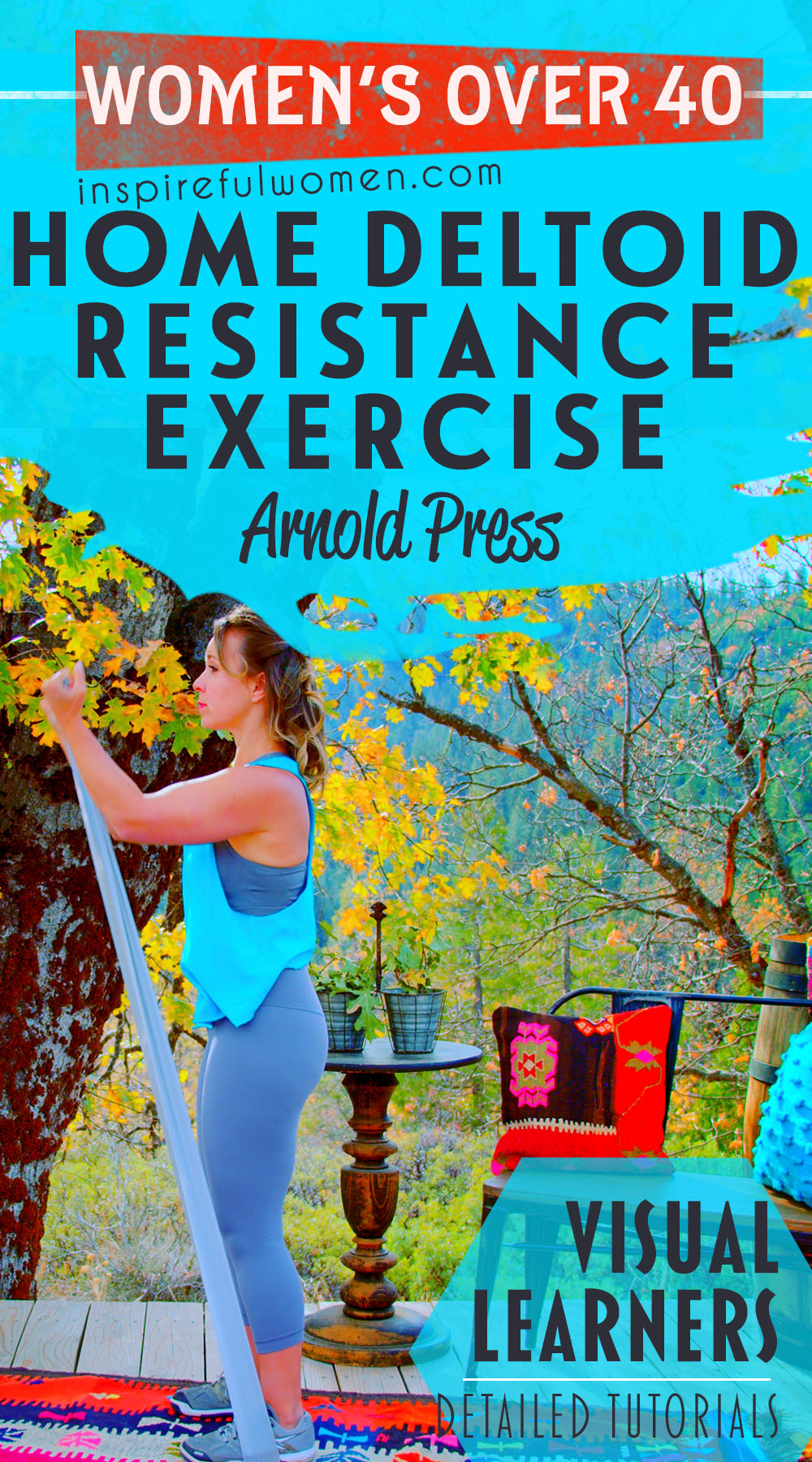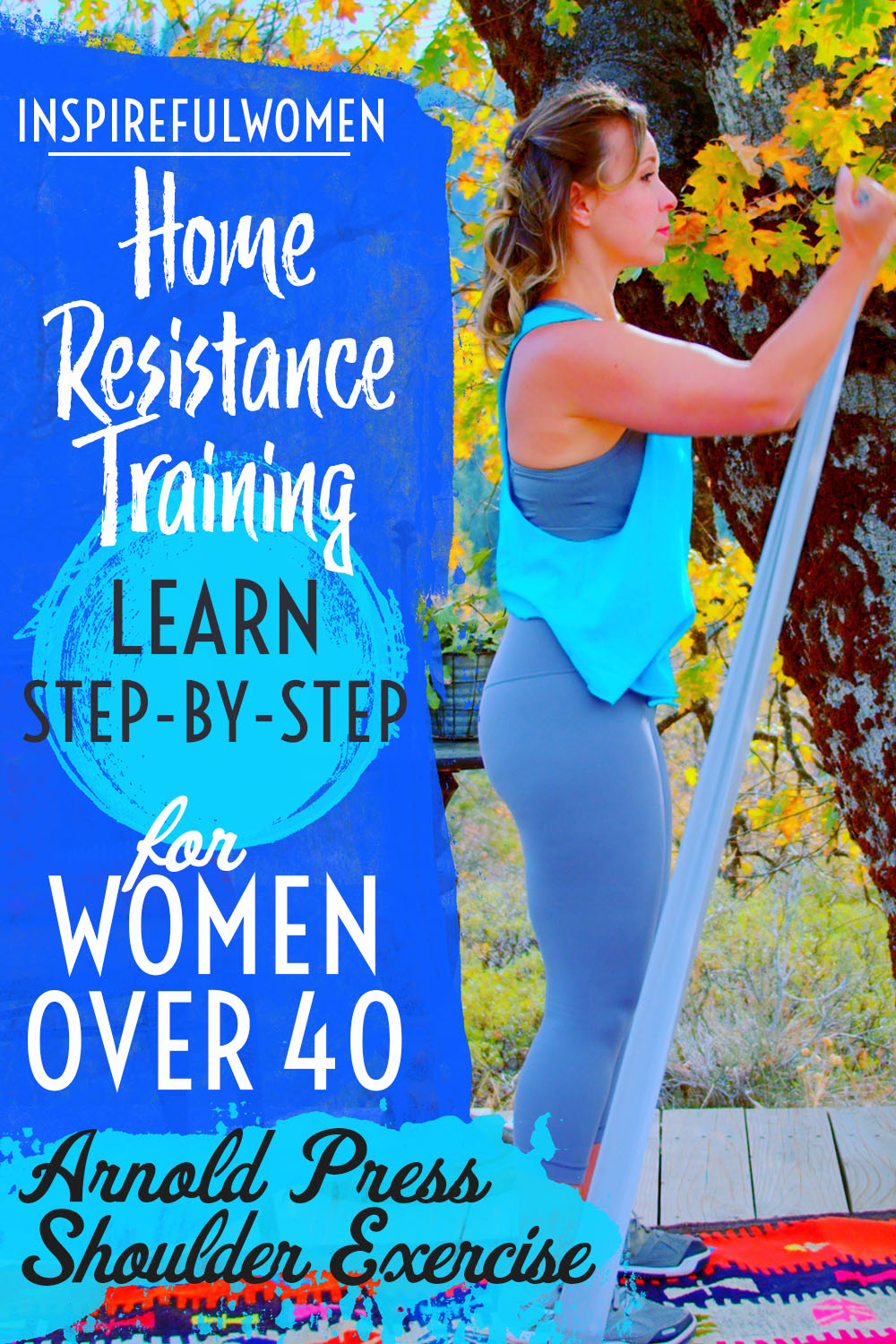Band Arnold Press
How to Do the Standing Arnold Shoulder Press Overhead with Resistance Band | In-Depth Guide [VISUAL LEARNERS] Advanced
Proper Form & Common Mistakes | Home Resistance Training
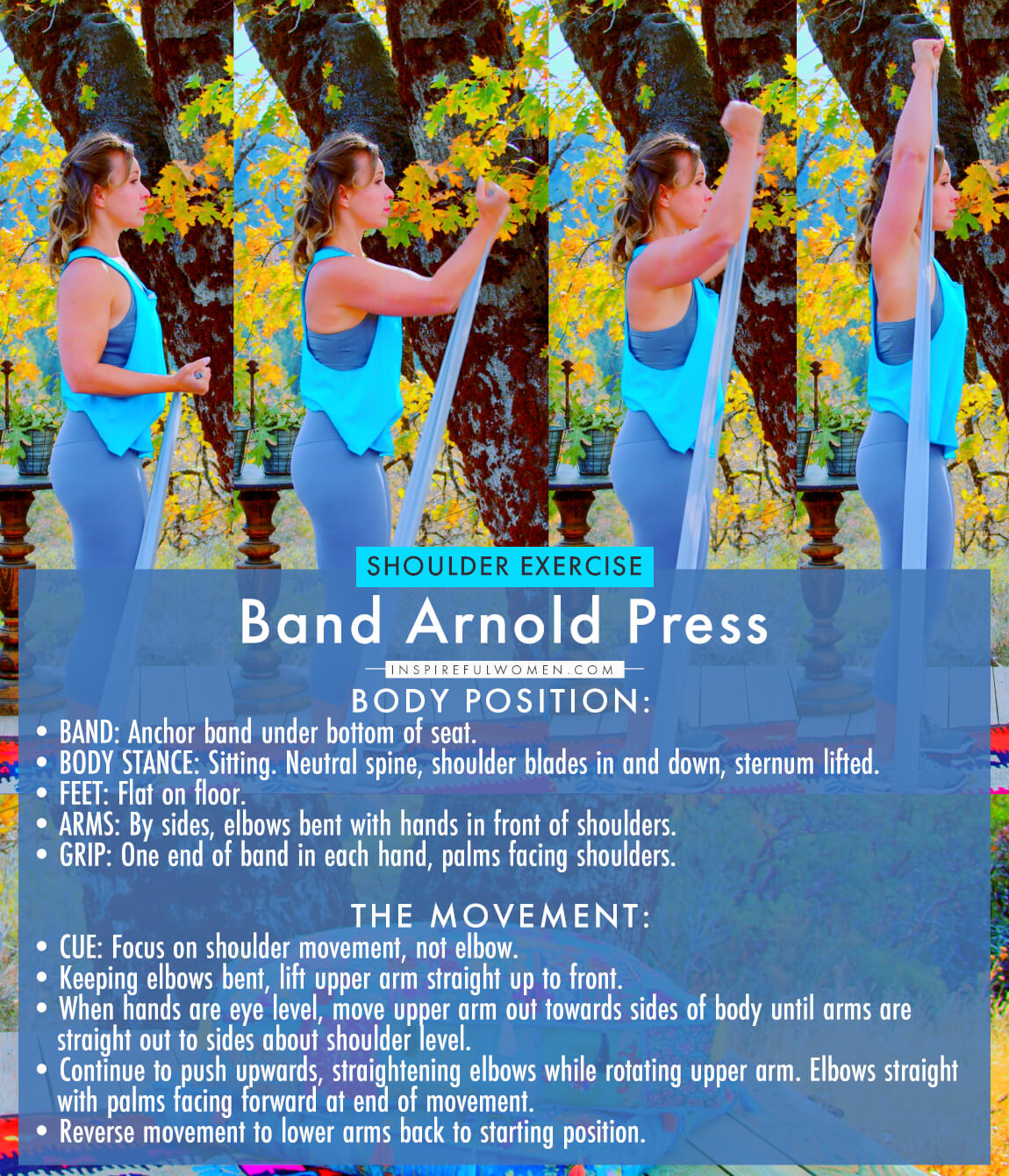
WHAT DO YOU WANT TO SEE?
QUICK DEMO
QUICK DEMO
MUSCLES THIS WORKS
MUSCLES
MAIN MUSCLES WORKED IN the Band Arnold Press
Deltoids
AKA YOUR MAIN SHOULDER MUSCLE.
OTHER MUSCLES WORKED:
- Rotator cuff
- Scapular muscles
STARTING POINTERS
Starting Pointers
WHAT WE'RE DOING TODAY
ALL WE'RE DOING:
Watch the video for this one!
The Arnold press with band is an advanced exercise for strengthening and toning your shoulders, increasing mobility, and improving your posture. This overhead shoulder press variation uses an elastic band to provide resistance to the arm movement. The resistance will be the greatest when the arms are straight up overhead. This version will target the lateral and posterior fibers of the deltoid more than the anterior fibers. This option can be a little more stressful on the shoulder joints because the greatest resistance is in a position where the muscles are not as strong.
HOW TO DO THE EXERCISE
LOOKS
HOW Band Arnold PresseS SHAPE OUR BODY
Toned and defined capped shoulder. Less rounded back - improved posture.
PROPER FORM
PROPER FORM: Band Arnold Presses
EQUIPMENT, SETS & REPS
EQUIPMENT
Main set (3: Light/Med/Heavy)
X-Heavy Band (I recommend getting this too if you plan to use resistance bands frequently).
Chair or Stool
SUGGESTED STARTING WEIGHT FOR WOMEN:
Moderate resistance.
SETS & REPS:
2 sets of 8 reps.
PACE:
Moderate but controlled pace, both up and down.
BODY POSITION
BODY POSITION FOR THE Band Arnold Press
Slide the band under the seat bottom, and hold one end of the band in each hand.
BODY STANCE: Sitting up tall on a chair or stool. Neutral spine, shoulder blades in and down your back, sternum lifted.
FEET: Feet parallel, comfortable width apart.
ARMS: Upper arms by your sides, elbows bent with your hands about in front of your shoulders - like the ending position of a bicep curl.
HAND/GRIP: One end of the band in each hand. Supinated grip, your palms facing your body.
HOW TO DO
HOW TO DO Band Arnold PresseS
CUE: Concentrate on the movement (lifting, rotating, and lowering) of your upper arm - from your shoulder to your elbow. Only at the very end does your forearm rotate a little to turn your palms further.
Keep your elbows bent as you lift your upper arm straight up to the front.
When your hands are approximately eye level, begin to move your upper arm out towards the side of your body (into abduction) THROUGH YOUR SHOULDER JOINT (not forearm), with the goal of ending up with your upper arm in line with your body, when it is nearly at shoulder level.
Continue to push upwards, straightening your elbows, while rotating your upper arm (the part of your arm that is from your shoulder to elbow only) so that your palms will be facing forward at the end of the movement. Straighten your elbows.
Reverse the movement to lower your arms back to the starting position. Your arms will rotate as they are brought back down.
HOW TO SAFELY GET OUT OF THE EXERCISE
Return your hands to the starting position in front of your body. Straighten your elbows and release the band.
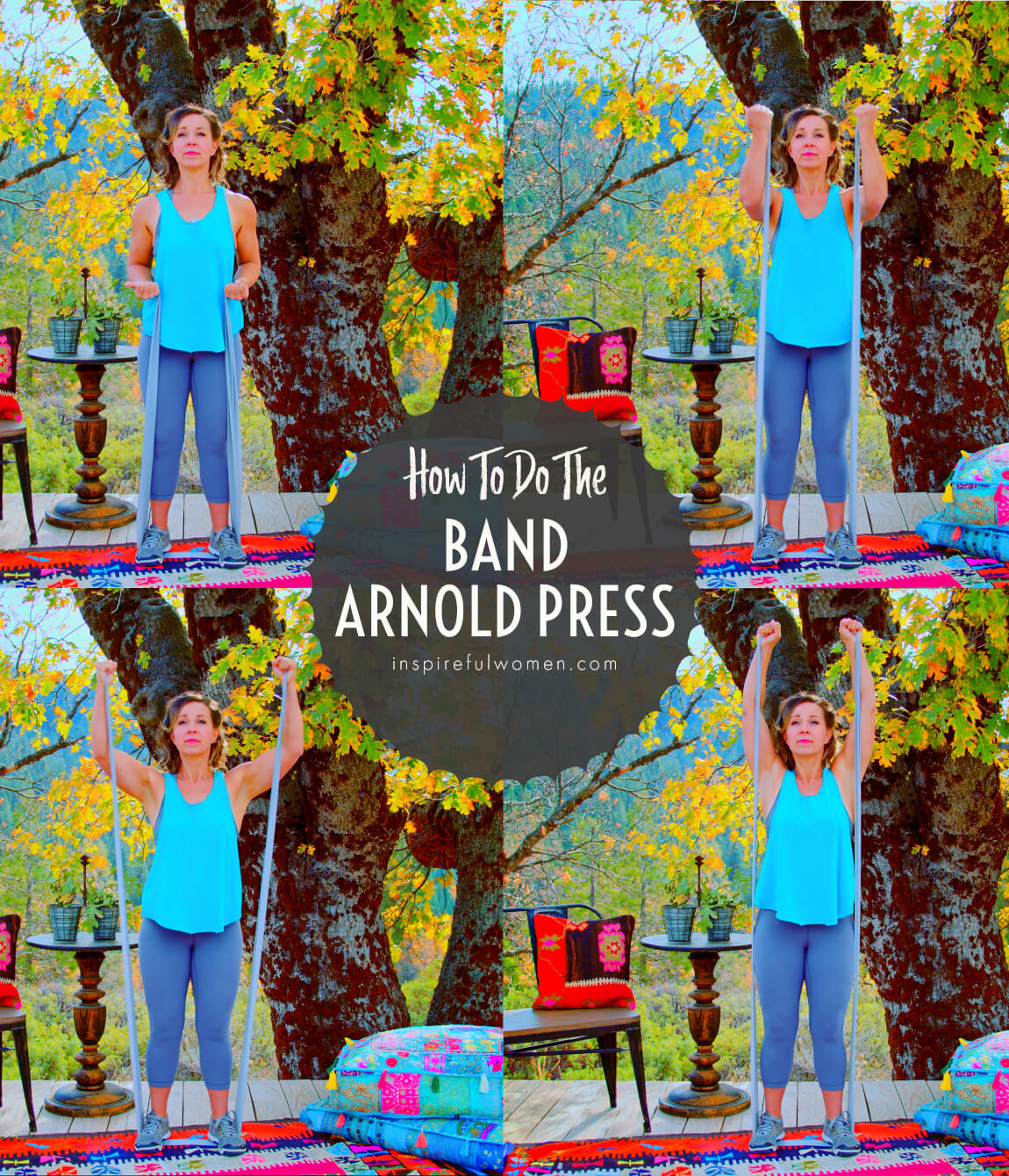
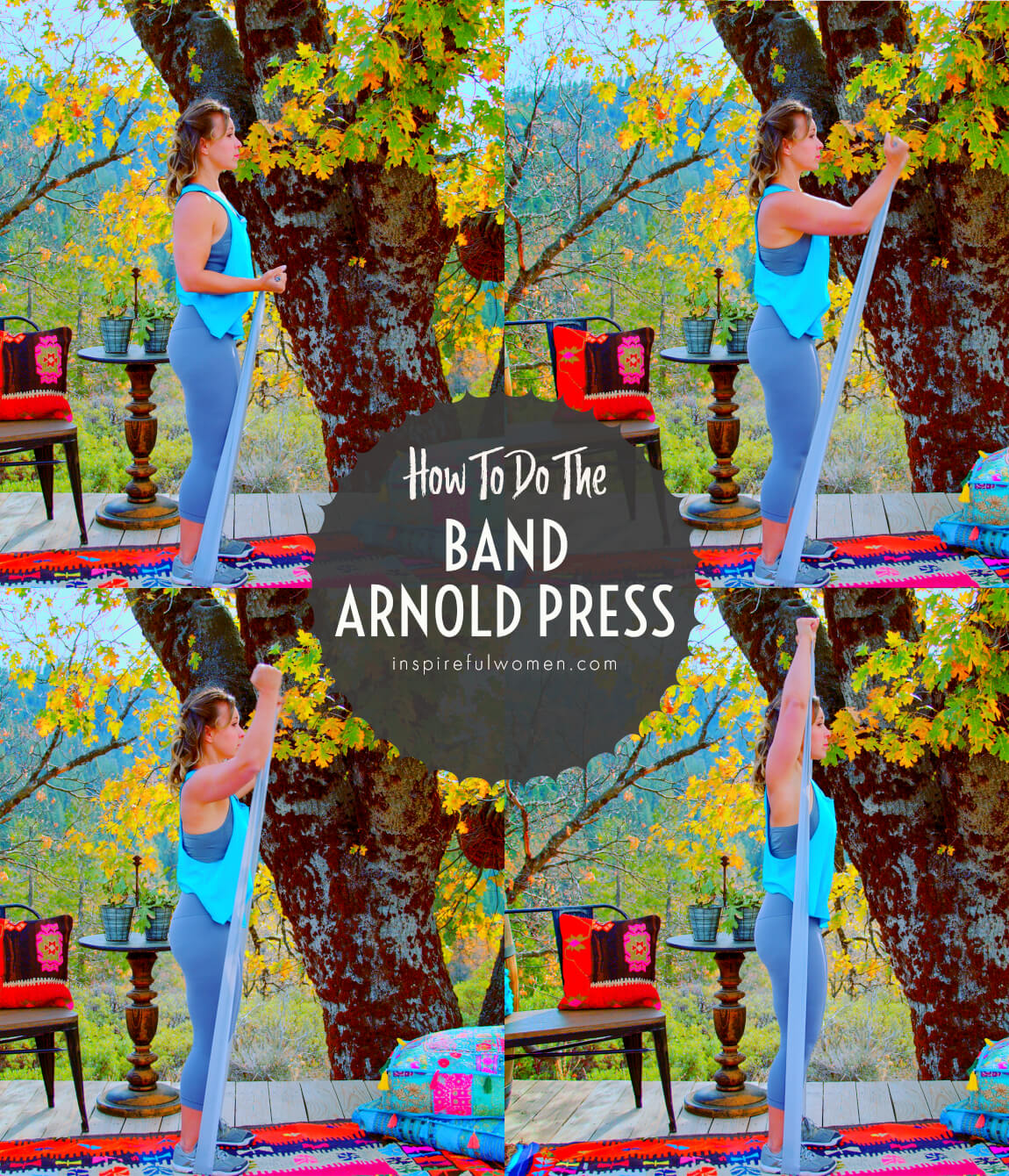
COMMON MISTAKES
COMMON MISTAKES
WHAT TO AVOID WITH THE Band Arnold Press
KEY TIP:
Guess what? Good news! Many avoids are the same for most movements. Once you learn the basics, there's really only a few extra avoids for each individual movement.
1. Avoid Dropping Weight Back Down
AVOID: Letting the arms drop.
WHY NOT?
- The ability to control the movement as gravity is pulling the arms down is a very important part of the exercise (eccentric muscle contraction.
WHAT TO DO:
- When the arms come down the movement should be slow and controlled.
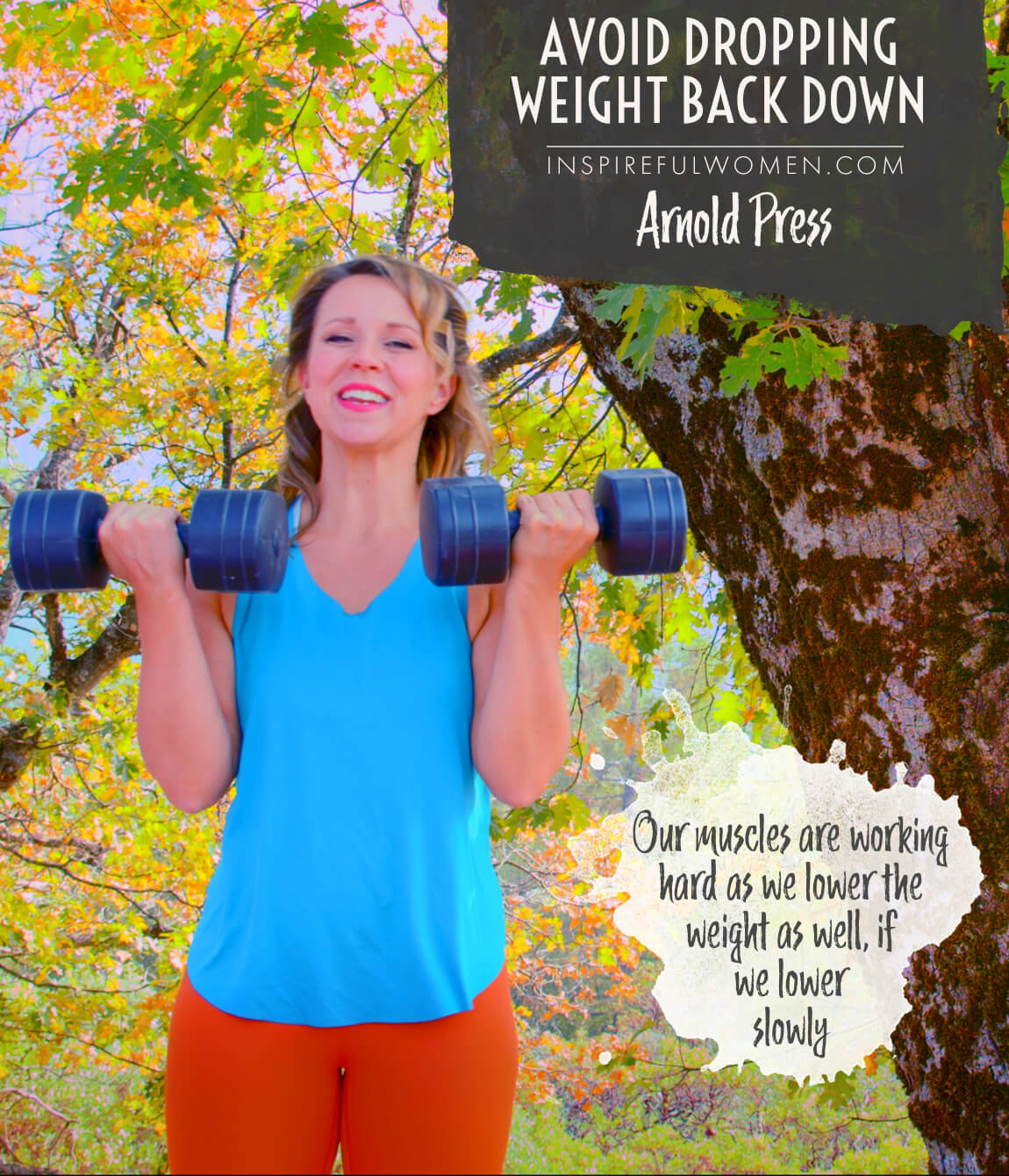
2. Avoid Rounding Shoulders Forward
AVOID: Letting the shoulder blades protract (move forward on the rib cage) as the arms move down.
WHY NOT?
- This puts the shoulder joint in a position that could irritate the bicep and rotator cuff tendons.
WHAT TO DO:
- Keep the shoulder blades tight together/retracted.

3. Avoid Shoulders Rising Up Towards Ears
AVOID: Letting the shoulders rise up close to your ears as you take your arms up overhead.
WHY NOT?
- This can happen when you use too much resistance or your muscles are getting tired.
- The upper trap will lift the shoulder blade up and the space between the top of the shoulder will rise up towards the earlobe.
- This means that you are trying to use the wrong muscles - the muscles that cross your neck, to lift the weight.
- This can result in neck or shoulder pain and will not strengthen the targeted muscles (will train poor body mechanics).
WHAT TO DO:
- Keep your shoulder blades down (they will rotate up but they should not move up your back).
- Keep space between the top of the shoulder and the earlobe, lift the sternum, and activate the core muscles.
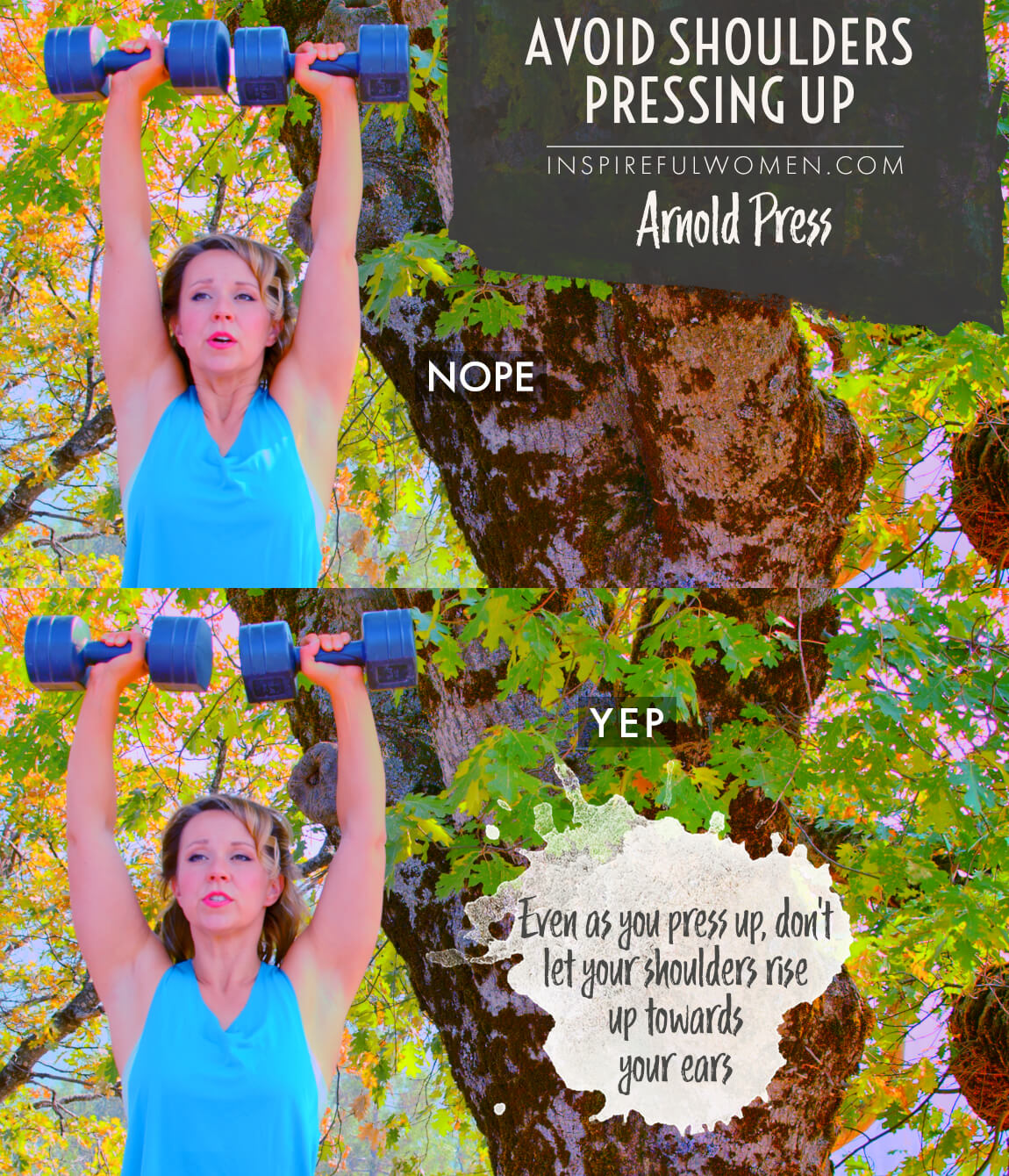
4. Avoid Misalignment Of Forearms
AVOID: Letting the arms and elbows cave in front of you too much/too close together
WHAT TO DO:
- Elbows should be in line with the shoulders and the hands.
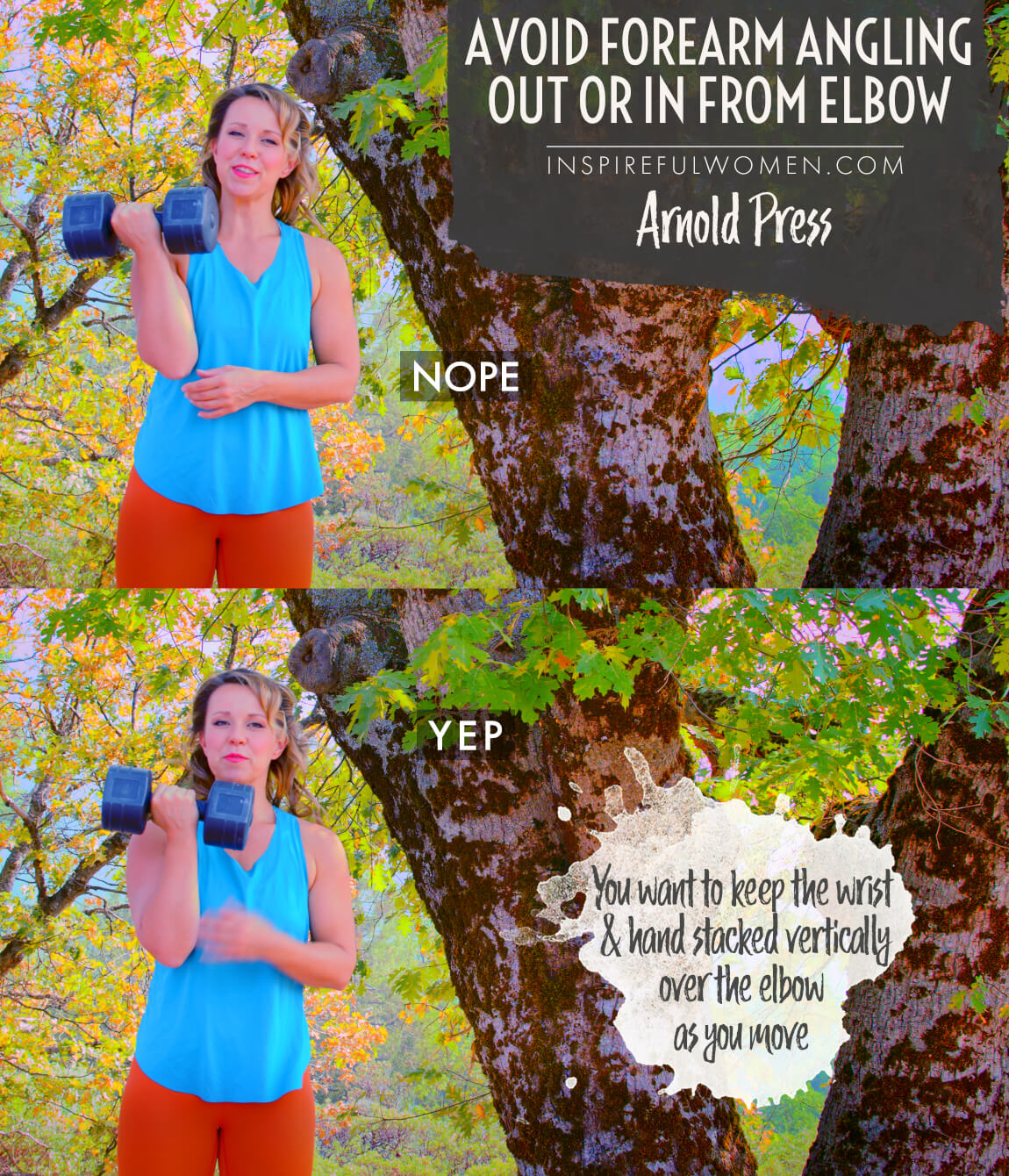
WHAT WE'RE DOING TODAY
WHAT & WHY
BENEFITS OF TRAINING THE shoulders
WHAT
CHANGING UP THE REGULAR OL' SHOULDER PRESS
The Arnold Press is an overhead pressing movement that works many of the muscles of the upper body in coordination. This is a more advanced shoulder press variation, so it is very helpful if you can comfortably do a standard overhead shoulder press before progressing to the Arnold Press.
This movement involves lifting the arms up and out to the side as they are lifted overhead. This movement sounds pretty straightforward, but there is a lot going on here. The arm is moving in five different directions! Forward, to the side, to the back, and rotating in and out. The muscles that move and stabilize the shoulder blade, along with the rotator cuff muscles will be working throughout the entire movement to make sure that the arm is correctly positioned in the shoulder joint.
The Arnold Press is designed to work all three parts of the deltoid muscle, the front, side, and back fibers. It can help to think of the movement as three separate movements that target each part.
Think of the arm lifting up, moving out towards the side and slightly back as the arms are pressed overhead. In addition to this, there is a rotation that happens in the shoulder joint. It is helpful to think of the upper arm bone rotating in the shoulder socket as opposed to thinking about the forearm position.
Make sure you have warmed up your upper body before doing this movement. It is also important to pay close attention to proper form during this particular movement to keep your shoulders and back safe. Avoid the urge to do too many reps or use too much weight in the beginning, and always monitor your response during and after - even a day or two.
WHY BOTHER DOING IT?
WHY
WHY DO WE EVEN CARE?
TRAIN IN ALL 3 PLANES OF MOTION WITH ONE EXERCISE
The Arnold press is an advanced movement that works many upper body muscles with one exercise. There are three parts of the deltoid muscle, the front fibers (anterior deltoid), the middle fibers (lateral deltoid), and the rear fibers (posterior deltoid). Each part of the deltoid has a different function the front fibers can lift the arm to the front and also rotate it in, the middle fibers lift the arm out to the side, and the posterior fibers move the arm back and rotate it out. All three parts of the deltoid along with the rotator cuff and the muscles that move the shoulder blade need to work in coordination for controlled and healthy movements of the arm.
This exercise trains the muscles to work together as the arm moves through three different planes of motion. The muscles all work together in coordination as the arm moves through all three planes of motion as it is lifted out to the front, out towards the side, and upwards and back. The arm also moves through rotation.
PREVENT INJURING ONE OF THE MOST COMMONLY INJURED JOINTS
Damage to the shoulder joint is pretty common. Almost everyone either has had shoulder pain or an injury or knows someone who has. It is also one area that can be most debilitating. Shoulder pain can limit your ability to do essential daily activities like dressing, toileting, grooming, and eating. It is also extremely difficult to sleep when you have a shoulder injury. Training the muscles of the upper back and shoulder can help to improve the stability and mobility of the shoulder joint to prevent damage to the joint.
The main cause of damage to the shoulder joint is poor movement (poor joint mechanics). The shoulder joint is the most mobile joint in the body. Along with this great amount of movement comes instability. That is where good joint mechanics are most essential. “Sloppy” joints can result in abnormal wear and tear on the joints, eventually causing breakdowns like torn tendons or cartilage, bone erosion, or spurring. The abnormal wear can change the shape of the joint surfaces to the point where fitting the “ball” of the upper arm bone into the “socket” of the shoulder blade is like trying to put a square peg into a round hole.
EVERYDAY LIFE
EVERYDAY LIFE &
MUSCLE FUNCTION
HOW WE USE OUR muscle MUSCLES IN EVERYDAY LIFE
1. ANTERIOR FIBERS ACT TO LIFT THE ARMS OUT TO THE FRONT AND OVERHEAD
- Reaching into a cabinet - in front or higher shelves
- Washing windows
- Painting walls and ceilings
- Changing light bulbs
- Picking items up from the floor
- Lifting a toddler out of a crib
2. LATERAL FIBERS ACT TO LIFT THE ARM OUT TO THE SIDE
- Lifting heavy objects (buckets, water softener salt bags) by the side of the body
- Dressing the upper body
- Washing hair
3. POSTERIOR OR REAR FIBERS ACT TO MOVE THE ARM BACK
- Reaching behind the body
- Tending a kid in the back seat
- Reaching into the back pocket
- Bringing the arm back to throw a ball (overhand)
- Pulling a car door shut, a refrigerator door open
- Rotating the arm out (external rotation)
- Reaching the back of your head for washing, brushing your hair
- Pulling a shirt off over your head
- Reaching the top of a zipper
- Receiving change in the palm of the hand
4. ALL THREE PARTS OF THE DELTOID (ANTERIOR, MIDDLE FIBERS OF THE DELTOID) WORK TO STABILIZE THE SHOULDER JOINT
- Improves the ability to lift and carry heavy objects (the arm has a stable base to work off of).
- Against a downward pull
- Walking a dog on a leash
- Holding a toddler’s hand
- carrying suitcases, buckets, water softener salt bags (heavy objects) by the side of the body
HOW TO FEEL WHAT MUSCLE IS WORKING
How to Feel What Muscle is Working
This is the most superficial muscle of the shoulder.
Place a hand on the opposite shoulder and lift the arm up - you will feel the muscle activate under your hand.
Try lifting to the front to feel the anterior fibers.
Lift to the side to feel the lateral fibers.
Push the arm back to feel the posterior fibers.
SCIENCY STUFF
ALLLL MUSCLES & WHEN
ALL MUSCLES WORKING & WHEN DURING THE Band Arnold Press
The scapular stabilizers are active to hold the shoulder blades down and back. The muscles that cross the wrist and elbow work to stabilize the joints throughout the movement.
The anterior deltoid, biceps, and coracobrachialis work concentrically to flex the arm. As the arms lift up they begin to move out to the side (into abduction) of the body - the rotator cuff muscles and scapular (shoulder blade) stabilizers work to coordinate the small movements of the shoulder blade and upper arm bone (humerus). The middle (medial) deltoid (concentric contraction) becomes more active as the arms are abducted (away from the body) approaching that midway, shoulder-height level and above. As the upper arm rotates back into extension and the arm is straightened, the rear deltoid and infraspinatus (concentric contraction) become more active. The triceps work to straighten the elbow as the arm pushes up over the head.
PIN IT FOR LATER!
